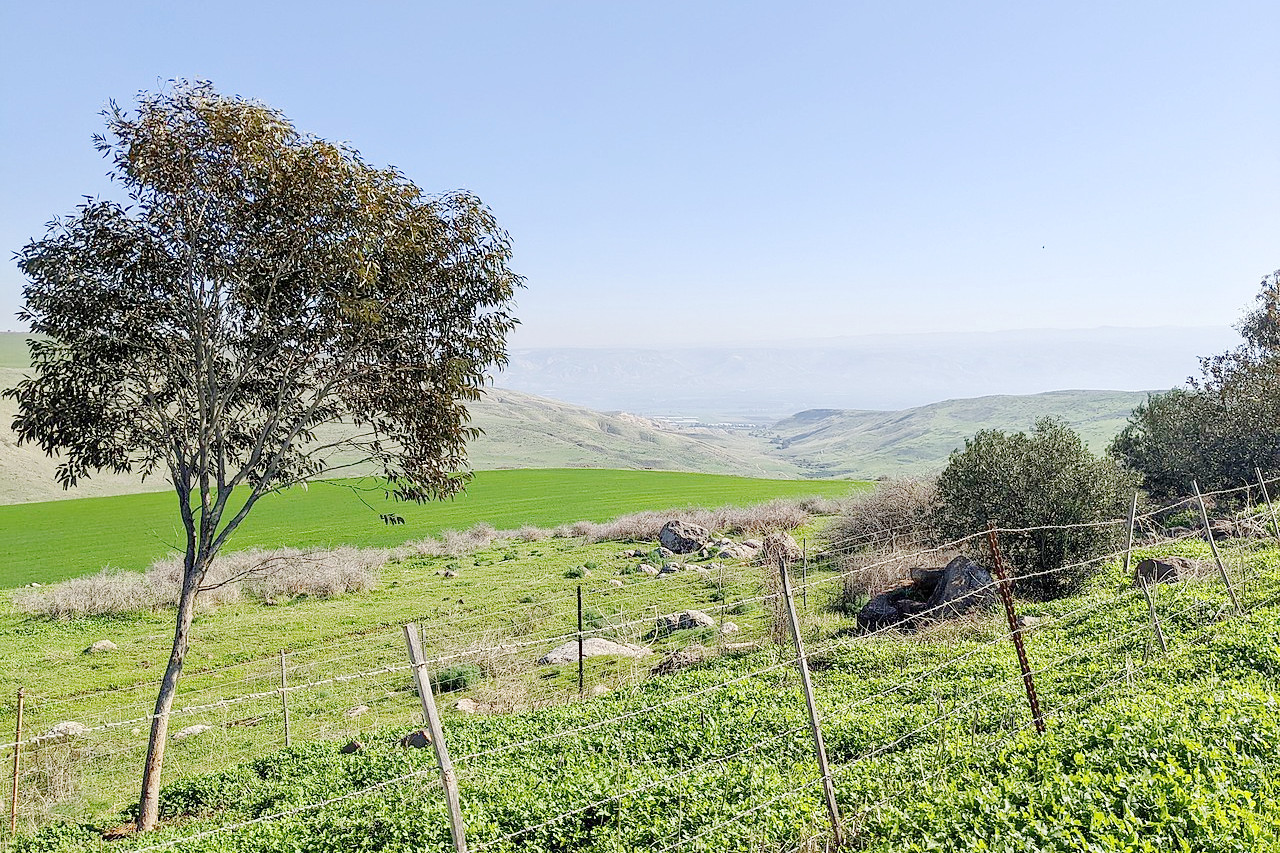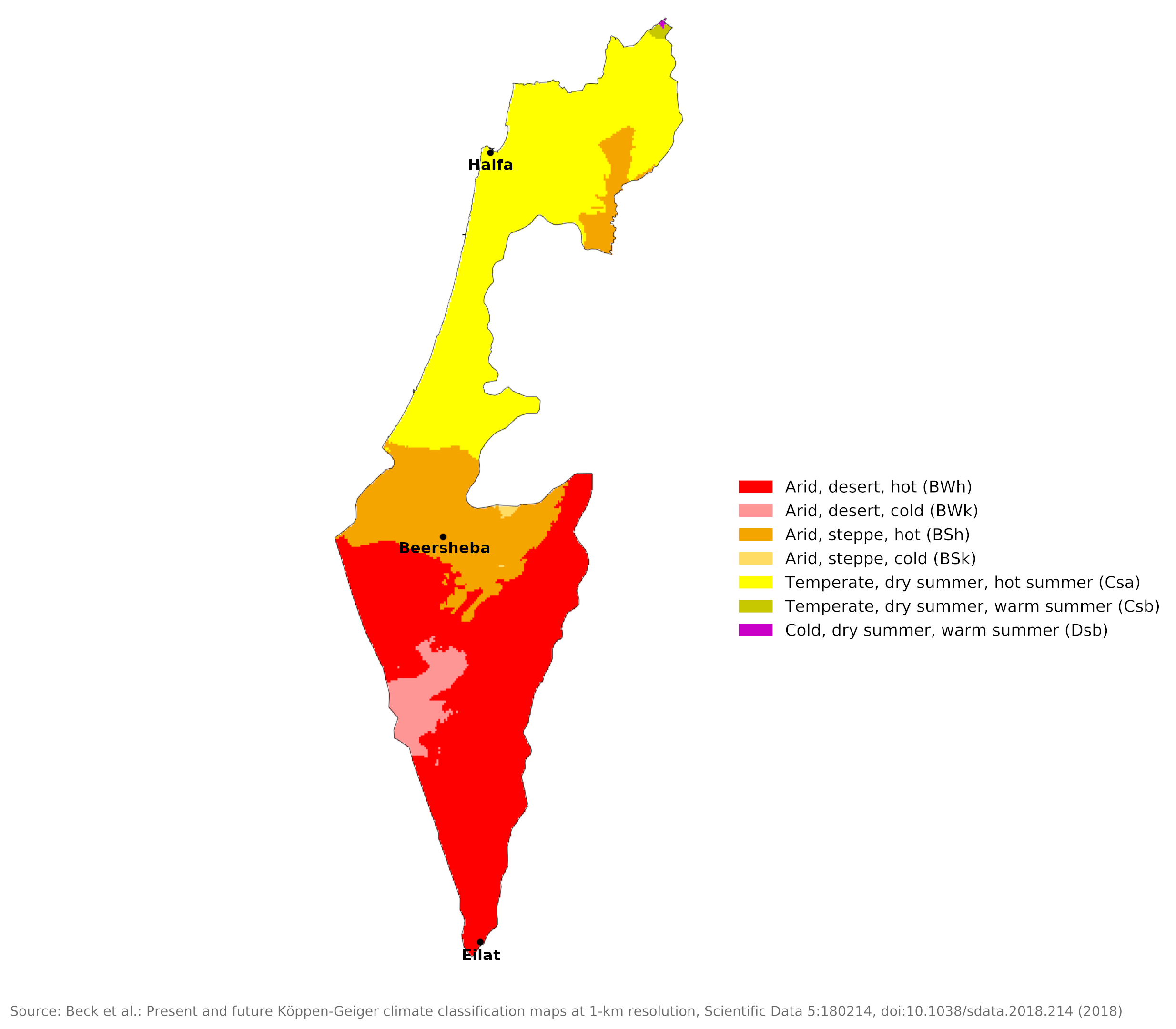The Climate of
Israel
 Issachar Plateauin the eastern part of Lower Galilee
Issachar Plateauin the eastern part of Lower Galilee
Climate Map
 Climate map of Israel
Climate map of Israel
What is the climate of Israel like?
Israel is a small country on the eastern shores of the Mediterranean with land borders with Lebanon and Syria on the north, Jordan on the east, and Egypt on the south. About 60% of the country consists of the Negev desert.
Israel has a Mediterranean climate. Summers are long, hot and dry; Winters are short, warm and wet. The main contrast of weather and climate in Israel is between the Negev and the northern part of the country. Average summer temperatures range from 24°C (75°F) in Safed in the hills of Galilee to 34°C (93°F) in Eilat, the southernmost point of the Negev desert, where August maximum temperatures can reach 46°C (114°F).
About 70 percent of the country's average rainfall occurs between November and March; June to August are often rainless. Precipitation decreases sharply as one moves south. In the extreme south, the average fall is less than 100 millimeters (4 inches) per year; in the north, the average annual rainfall is around 1,000 millimeters (40 inches). Rainfall is often concentrated in violent storms, causing erosion and flooding. The most cultivated areas of the country are those that receive more than 300 millimeters (12 inches) of rainfall annually; about a third of the land is cultivable.
The northern part of Israel is typically Mediterranean with plenty of sunshine, mild, wet winters and long, hot, dry summers. The winter rains can be quite heavy but fall on a small number of days. On the coast, the summer heat is sometimes quite oppressive and muggy, but is tempered by the afternoon sea breeze. Winters here are mild, and frost and snow are very rare occurrences (see the Haifa example).
| Climate data for Haifa (1995–2010) | |||||||||||||
|---|---|---|---|---|---|---|---|---|---|---|---|---|---|
| Month | Jan | Feb | Mar | Apr | May | Jun | Jul | Aug | Sep | Oct | Nov | Dec | Year |
| Average high °C (°F) | 17.8 (64.0) | 18.6 (65.5) | 20.9 (69.6) | 23.8 (74.8) | 26.5 (79.7) | 29.5 (85.1) | 31.6 (88.9) | 31.6 (88.9) | 30.2 (86.4) | 27.9 (82.2) | 24.4 (75.9) | 19.8 (67.6) | 25.2 (77.4) |
| Daily mean °C (°F) | 13.9 (57.0) | 14.4 (57.9) | 16.5 (61.7) | 19.4 (66.9) | 22.4 (72.3) | 25.7 (78.3) | 28.0 (82.4) | 28.4 (83.1) | 26.7 (80.1) | 23.7 (74.7) | 19.8 (67.6) | 15.8 (60.4) | 21.2 (70.2) |
| Average low °C (°F) | 10.0 (50.0) | 10.2 (50.4) | 12.1 (53.8) | 14.8 (58.6) | 18.2 (64.8) | 21.9 (71.4) | 24.4 (75.9) | 25.1 (77.2) | 23.2 (73.8) | 19.5 (67.1) | 15.1 (59.2) | 11.8 (53.2) | 15.9 (60.6) |
| Average precipitation mm (inches) | 124.9 (4.92) | 95.2 (3.75) | 52.8 (2.08) | 23.6 (0.93) | 2.7 (0.11) | 0.1 (0.00) | 0.0 (0.0) | 0.0 (0.0) | 1.2 (0.05) | 28.0 (1.10) | 77.8 (3.06) | 135.5 (5.33) | 541.8 (21.33) |
| Source: Israel Meteorological Service | |||||||||||||
Inland, the country is hilly, with elevations ranging from 500 to 1,000 meters (1,650 to 3,300 feet). It rains a little more heavily here and snow can occasionally fall. Nights are cool in winter and crisp and cool in summer. Summer heat in the hills is drier and less oppressive than on the coast.
In the southern Negev desert, annual rainfall is low, decreasing from about 200 millimeters (8 inches) in the north (see Beersheba) to just 25 millimeters (1 inch) at Eilat on the Gulf of Aqaba. The sparse rain in the Negev comes as short but heavy local showers. These can occur any time from September to April. Cloudy skies are rare here, even in midwinter. Winter nights can be quite cold with frost. Except when the Khamsin wind blows, desert nights are rarely very hot and can feel fresh after the dry heat of the day.
| Climate data for Beersheba | |||||||||||||
|---|---|---|---|---|---|---|---|---|---|---|---|---|---|
| Month | Jan | Feb | Mar | Apr | May | Jun | Jul | Aug | Sep | Oct | Nov | Dec | Year |
| Average high °C (°F) | 17.7 (63.9) | 18.7 (65.7) | 22.0 (71.6) | 26.5 (79.7) | 30.5 (86.9) | 33.1 (91.6) | 34.7 (94.5) | 34.7 (94.5) | 32.9 (91.2) | 29.7 (85.5) | 25.0 (77.0) | 20.0 (68.0) | 27.1 (80.8) |
| Daily mean °C (°F) | 12.4 (54.3) | 13.2 (55.8) | 15.9 (60.6) | 19.7 (67.5) | 23.2 (73.8) | 26.1 (79.0) | 28.0 (82.4) | 28.1 (82.6) | 26.2 (79.2) | 23.2 (73.8) | 18.6 (65.5) | 14.4 (57.9) | 20.7 (69.4) |
| Average low °C (°F) | 7.1 (44.8) | 7.7 (45.9) | 9.8 (49.6) | 12.8 (55.0) | 16.0 (60.8) | 19.0 (66.2) | 21.3 (70.3) | 21.5 (70.7) | 19.6 (67.3) | 16.7 (62.1) | 12.2 (54.0) | 8.8 (47.8) | 14.4 (57.9) |
| Average precipitation mm (inches) | 48 (1.9) | 40 (1.6) | 29 (1.1) | 9 (0.4) | 3.6 (0.14) | 0 (0) | 0 (0) | 0 (0) | 0.5 (0.02) | 9 (0.4) | 18 (0.7) | 38 (1.5) | 195.1 (7.76) |
| Source: Israel Meteorological Service | |||||||||||||
| Climate data for Eilat (1980–2010) | |||||||||||||
|---|---|---|---|---|---|---|---|---|---|---|---|---|---|
| Month | Jan | Feb | Mar | Apr | May | Jun | Jul | Aug | Sep | Oct | Nov | Dec | Year |
| Average high °C (°F) | 21.3 (70.3) | 23.0 (73.4) | 26.1 (79.0) | 31.0 (87.8) | 35.7 (96.3) | 38.9 (102.0) | 40.4 (104.7) | 40.0 (104.0) | 37.3 (99.1) | 33.1 (91.6) | 27.7 (81.9) | 23.0 (73.4) | 31.5 (88.6) |
| Daily mean °C (°F) | 15.8 (60.4) | 17.4 (63.3) | 20.5 (68.9) | 24.7 (76.5) | 29.1 (84.4) | 32.0 (89.6) | 33.8 (92.8) | 33.7 (92.7) | 31.3 (88.3) | 27.4 (81.3) | 22.0 (71.6) | 17.1 (62.8) | 25.4 (77.7) |
| Average low °C (°F) | 10.4 (50.7) | 11.8 (53.2) | 14.6 (58.3) | 18.4 (65.1) | 22.5 (72.5) | 25.2 (77.4) | 27.3 (81.1) | 27.4 (81.3) | 25.2 (77.4) | 21.8 (71.2) | 16.3 (61.3) | 11.9 (53.4) | 19.4 (66.9) |
| Average precipitation mm (inches) | 4 (0.2) | 3 (0.1) | 3 (0.1) | 2 (0.1) | 1 (0.0) | 0 (0) | 0 (0) | 0 (0) | 0 (0) | 4 (0.2) | 2 (0.1) | 5 (0.2) | 24 (1) |
| Source: Israel Meteorological Service | |||||||||||||
The worst weather in Israel, as in neighboring countries, occurs when hot, dry winds bring high temperatures from the Arabian Desert. The hot, dry desert wind called Khamsin can bring the high summer temperatures to high levels and fill the air with sand and dust. These Khamsin winds are known in Israel under the Hebrew name Sharav. They are most common and most severe at the beginning and end of the hot, dry summer period.
Israel has a very sunny climate, averaging six to seven hours of sunshine per day in winter and twelve to thirteen hours in summer.
References
- E. A. Pearce, Charles Gordon Smith, (1990) The Hutchinson World Weather Guide, John Murray Press. ISBN 1859863426
- Timothy L. Gall, (ed.), (2003), Worldmark Encyclopedia of the Nations, Eleventh Edition, Thomson Gale
- Federal Research Division, Library of Congress, (1990), Israel: a country study. Claitor's Pub. Division.
- Hugh Chisholm, (ed.), (1911), Encyclopædia Britannica, Eleventh edition, Cambridge University Press
The Climate of
Israel

In summary:
Israel has a Mediterranean climate. Summers are hot and dry; winters are short, warm, and wet. Average summertime temperatures range from 24°C (75°F) in the hills of Galilee, to 34°C (93°F) at the southernmost point of the Negev Desert. The hot, dry desert wind called the hamsin can raise the high summer temperatures even higher, as well as fill the air with sand and dust.
Rainfall ranges from 25 mm (1 in) per year south of the Dead Sea to 1200 mm (44 in) in the hills of Galilee. Most rain falls between October and April.